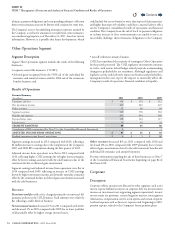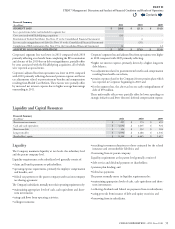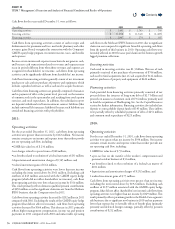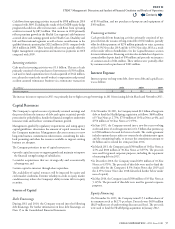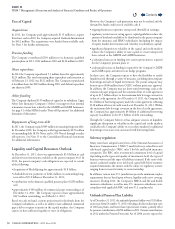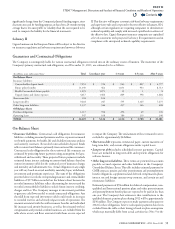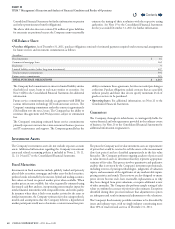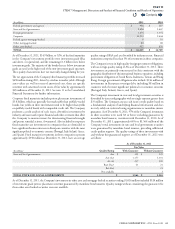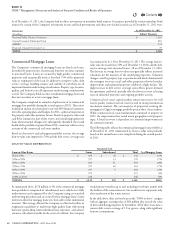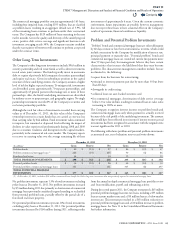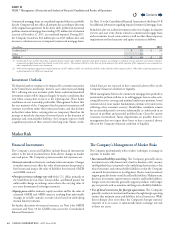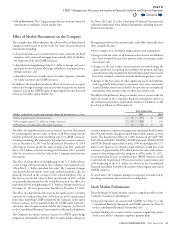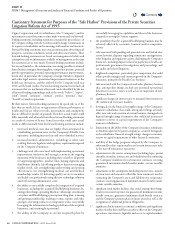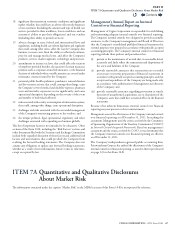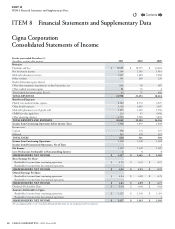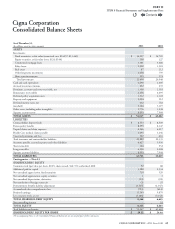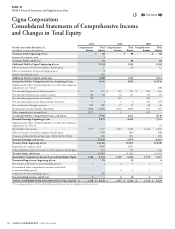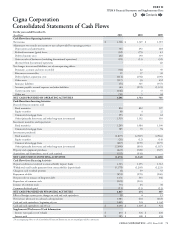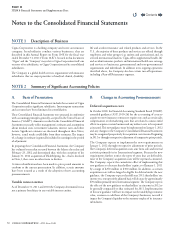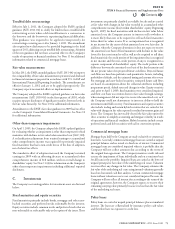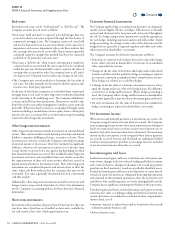Cigna 2011 Annual Report Download - page 86
Download and view the complete annual report
Please find page 86 of the 2011 Cigna annual report below. You can navigate through the pages in the report by either clicking on the pages listed below, or by using the keyword search tool below to find specific information within the annual report.
64 CIGNA CORPORATION2011 Form10K
PART II
ITEM 7 Management’s Discussion and Analysis of Financial Condition and Results of Operations
Commercial mortgage loans are considered impaired when it is probable
that the Company will not collect all amounts due according to the terms
of the original loan agreement. In the above table, problem and potential
problem commercial mortgage loans totaling $195million (net of valuation
reserves) at December31,2011, are considered impaired. During 2011,
the Company recorded a $16million pre-tax ($11million after-tax)
increase to valuation reserves on impaired commercial mortgage loans.
See Note11 to the Consolidated Financial Statements of this Form10-K
for additional information regarding impaired commercial mortgage loans.
Included in after-tax realized investment results were changes in valuation
reserves and asset write-downs related to commercial mortgage loans
and investments in real estate entities as well as other-than-temporary
impairments on xed maturity and equity securities as follows:
(In millions)
2011 2010
Credit-related(1) $ 18 $ 24
Other 16 1
TOTAL2 $ 34 $ 25
(1) Credit-related losses include other-than-temporary declines in fair value of fixed maturities and equity securities, and changes in valuation reserves and asset write-downs related to
commercial mortgage loans and investments in real estate entities. The amount related to credit losses on fixed maturities for which a portion of the impairment was recognized in
other comprehensive income was immaterial.
(2) Other-than-temporary impairments on fixed maturities of $17million in 2011 are included in both the credit related and other categories above. Other-than-temporary impairments
on fixed maturities in 2010 were immaterial.
Investment Outlook
e nancial markets continue to be impacted by economic uncertainty
in the UnitedStates and Europe, however, asset values increased during
2011, reecting a decrease in market yields. Future realized and unrealized
investment results will be impacted largely by market conditions that
exist when a transaction occurs or at the reporting date. ese future
conditions are not reasonably predictable. Management believes that
the vast majority of the Company’s xed maturity investments will
continue to perform under their contractual terms, and that declines
in their fair values below carrying value are temporary. Based on the
strategy to match the duration of invested assets to the duration of
insurance and contractholder liabilities, the Company expects to hold
a signicant portion of these assets for the long term. Future credit-
related losses are not expected to have a material adverse eect on the
Company’s nancial condition or liquidity.
While management believes the commercial mortgage loan portfolio is
positioned to perform well due to its solid aggregate loan-to-value ratio,
strong debt service coverage and minimal underwater positions, broad
commercial real estate market fundamentals continue to be under stress
reecting a slow economic recovery. Should these conditions remain
for an extended period or worsen substantially, it could result in an
increase in problem and potential problem loans. Given the current
economic environment, future impairments are possible; however,
management does not expect those losses to have a material adverse
eect on the Company’s nancial condition or liquidity.
Market Risk
Financial Instruments
e Company’s assets and liabilities include nancial instruments
subject to the risk of potential losses from adverse changes in market
rates and prices. e Company’s primary market risk exposures are:
•
Interest-rate risk on xed-rate, medium-term instruments. Changes
in market interest rates aect the value of instruments that promise a
xed return and impact the value of liabilities for reinsured GMDB
and GMIB contracts.
•
Foreign currency exchange rate risk of the U.S. dollar primarily to
the South Korean won, Euro, Taiwan dollar, and British pound. An
unfavorable change in exchange rates reduces the carrying value of
net assets denominated in foreign currencies.
•
Equity price risk for domestic equity securities and for the value of
reinsured GMDB and GMIB contracts resulting from unfavorable
changes in variable annuity account values based on underlying
mutual fund investments.
For further discussion of reinsured contracts, see Note6 for GMDB
contracts and Note10 for GMIB contracts in the Consolidated
Financial Statements.
e Company’s Management of Market Risks
e Company predominantly relies on three techniques to manage its
exposure to market risk:
•
Investment/liability matching. e Company generally selects
investment assets with characteristics (such as duration, yield, currency
and liquidity) that correspond to the underlying characteristics of its
related insurance and contractholder liabilities so that the Company
can match the investments to its obligations. Shorter-term investments
support generally shorter-term life and health liabilities. Medium-term,
xed-rate investments support interest-sensitive and health liabilities.
Longer-term investments generally support products with longer
pay out periods such as annuities and long-term disability liabilities.
•
Use of local currencies for foreign operations. e Company
generally conducts its international business through foreign operating
entities that maintain assets and liabilities in local currencies. While
this technique does not reduce the Company’s foreign currency
exposure of its net assets, it substantially limits exchange rate risk
to those net assets.
Contents
Q


